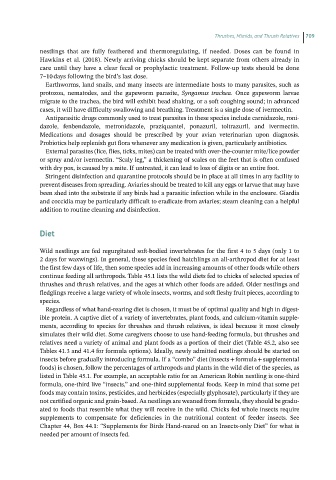Page 707 - Hand rearing birds second
P. 707
Thrushes, Mimids, and Thrush Relatives 709
nestlings that are fully feathered and thermoregulating, if needed. Doses can be found in
Hawkins et al. (2018). Newly arriving chicks should be kept separate from others already in
care until they have a clear fecal or prophylactic treatment. Follow‐up tests should be done
7–10 days following the bird’s last dose.
Earthworms, land snails, and many insects are intermediate hosts to many parasites, such as
protozoa, nematodes, and the gapeworm parasite, Syngamus trachea. Once gapeworm larvae
migrate to the trachea, the bird will exhibit head shaking, or a soft coughing sound; in advanced
cases, it will have difficulty swallowing and breathing. Treatment is a single dose of ivermectin.
Antiparasitic drugs commonly used to treat parasites in these species include carnidazole, roni-
dazole, fenbendazole, metronidazole, praziquantel, ponazuril, toltrazuril, and ivermectin.
Medications and dosages should be prescribed by your avian veterinarian upon diagnosis.
Probiotics help replenish gut flora whenever any medication is given, particularly antibiotics.
External parasites (lice, flies, ticks, mites) can be treated with over‐the‐counter mite/lice powder
or spray and/or ivermectin. “Scaly leg,” a thickening of scales on the feet that is often confused
with dry pox, is caused by a mite. If untreated, it can lead to loss of digits or an entire foot.
Stringent disinfection and quarantine protocols should be in place at all times in any facility to
prevent diseases from spreading. Aviaries should be treated to kill any eggs or larvae that may have
been shed into the substrate if any birds had a parasitic infection while in the enclosure. Giardia
and coccidia may be particularly difficult to eradicate from aviaries; steam cleaning can a helpful
addition to routine cleaning and disinfection.
Diet
Wild nestlings are fed regurgitated soft‐bodied invertebrates for the first 4 to 5 days (only 1 to
2 days for waxwings). In general, these species feed hatchlings an all‐arthropod diet for at least
the first few days of life, then some species add in increasing amounts of other foods while others
continue feeding all arthropods. Table 45.1 lists the wild diets fed to chicks of selected species of
thrushes and thrush relatives, and the ages at which other foods are added. Older nestlings and
fledglings receive a large variety of whole insects, worms, and soft fleshy fruit pieces, according to
species.
Regardless of what hand‐rearing diet is chosen, it must be of optimal quality and high in digest-
ible protein. A captive diet of a variety of invertebrates, plant foods, and calcium‐vitamin supple-
ments, according to species for thrushes and thrush relatives, is ideal because it most closely
simulates their wild diet. Some caregivers choose to use hand‐feeding formula, but thrushes and
relatives need a variety of animal and plant foods as a portion of their diet (Table 45.2, also see
Tables 41.3 and 41.4 for formula options). Ideally, newly admitted nestlings should be started on
insects before gradually introducing formula. If a “combo” diet (insects + formula + supplemental
foods) is chosen, follow the percentages of arthropods and plants in the wild diet of the species, as
listed in Table 45.1. For example, an acceptable ratio for an American Robin nestling is one‐third
formula, one‐third live “insects,” and one‐third supplemental foods. Keep in mind that some pet
foods may contain toxins, pesticides, and herbicides (especially glyphosate), particularly if they are
not certified organic and grain‐based. As nestlings are weaned from formula, they should be gradu-
ated to foods that resemble what they will receive in the wild. Chicks fed whole insects require
supplements to compensate for deficiencies in the nutritional content of feeder insects. See
Chapter 44, Box 44.1: “Supplements for Birds Hand‐reared on an Insects‐only Diet” for what is
needed per amount of insects fed.

